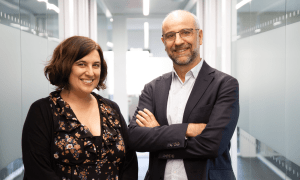World's third case of HIV cure after stem cell transplant

Nature Medicine confirms cure of HIV infection in Düsseldorf Patient, a man who, after receiving a stem cell transplant to treat leukaemia, discontinued supervised antiretroviral treatment for HIV and, four years later, remains HIV-free
The IciStem consortium, coordinated by IrsiCaixa and the University Medical Center of Utrecht, presents the third case of HIV cure in the world. The case is a man who underwent supervised withdrawal of antiretroviral treatment against HIV after undergoing a stem cell transplant to treat myeloid leukaemia. Four years later, the virus has not reappeared. The study is published in the Nature Medicine journal. The article demonstrates the absence of viral particles and immune response against the virus in the patient's body despite the absence of treatment for 4 years, evidence that allows the scientific team to consider the Düsseldorf patient as a new case of cure.
The study was carried out by the IciStem international consortium, coordinated by the IrsiCaixa AIDS Research Institute - a centre jointly promoted by the "la Caixa" Foundation and the Catalan Government's Department of Health - and the University Medical Center in Utrecht (The Netherlands). "Together with an excellent team of professionals from all over the world, we have been studying these exceptional cases for nine years. These patients have completely eliminated HIV thanks to a therapeutic strategy and we want to understand each step of the cure process in detail in order to design strategies that can be replicated in the entire population", explains Javier Martínez-Picado, ICREA researcher at IrsiCaixa, co-director of IciStem, and co-author of the article.
The Düsseldorf patient, a story of overcoming the odds
In 2008, a medical team in Düsseldorf, Germany, diagnosed HIV infection in a person who would later become known as the Düsseldorf patient because of his uniqueness. Following the diagnosis, the patient started on antiretroviral treatment, which controlled the infection and reduced the amount of virus to undetectable levels in his blood. Four years later, in 2012, he developed leukaemia, a cancer of the immune system cells, and had to undergo a stem cell transplant. In such unique cases, a stem cell donor is sought who has the CCR5Δ32 mutation. This genetic alteration means that you do not produce one of the gateways for HIV to enter the cells and therefore makes infection more difficult. "It is very complicated for all these factors to coincide, only 1% of the population has this mutation and, in addition, it is necessary for the donor to be a compatible blood donor to avoid transplant rejection", says Maria Salgado, IGTP researcher at IrsiCaixa and co-author of the study. In the case of the Düsseldorf patient, a woman made it possible to fit all the pieces together.
More than five years after the transplant, and having gone through two leukaemia relapses and several complications, the patient stabilised. Thereafter, the research team agreed to withdraw his antiretroviral treatment for HIV. Today, the Düsseldorf patient is 53 years old and in good health. "When he stopped treatment, we followed him for 44 months and did not detect any traces of virus in his blood or tissues," says Salgado. "Nor have we seen any immune response characteristic of a viral relapse. Their defences are not activated against HIV because they don't have to defend themselves against the virus”, she adds. All these data allow the scientific team to affirm that the person has been cured of HIV infection.
The global HIV cure landscape
Confirmation of cure for the Berlin and London patients precedes that of the Düsseldorf patient. Although these are the only three cases where considered cured, two other patients, in New York and at the City of Hope Hospital in Duarte, have already been presented at scientific conferences with remission of HIV. "Neither of them have special immune characteristics that allow them to control HIV infection spontaneously, but the virus has been eliminated from the body as a result of medical intervention. This differentiates these cases of eradication from the cases of functional cure in elite or post-treatment controllers achieved so far, where people's own bodies had special factors that allowed them to control the virus," says Salgado. The Düsseldorf patient is thus a third proof of concept that demonstrates the possibility of curing HIV and rekindles hope in the scientific community dedicated to fighting the virus.
However, this strategy is very aggressive and not scalable to the rest of the population. Stem cell transplantation is only applied to people who suffer from a haematological disease and have no therapeutic alternative. In the case of people with HIV, there is an alternative, and that is antiretroviral treatment. "One possible strategy that is already being worked on is to introduce the CCR5Δ32 mutation through gene therapy to achieve a cure for HIV without having to undergo a transplant," says Martínez-Picado.